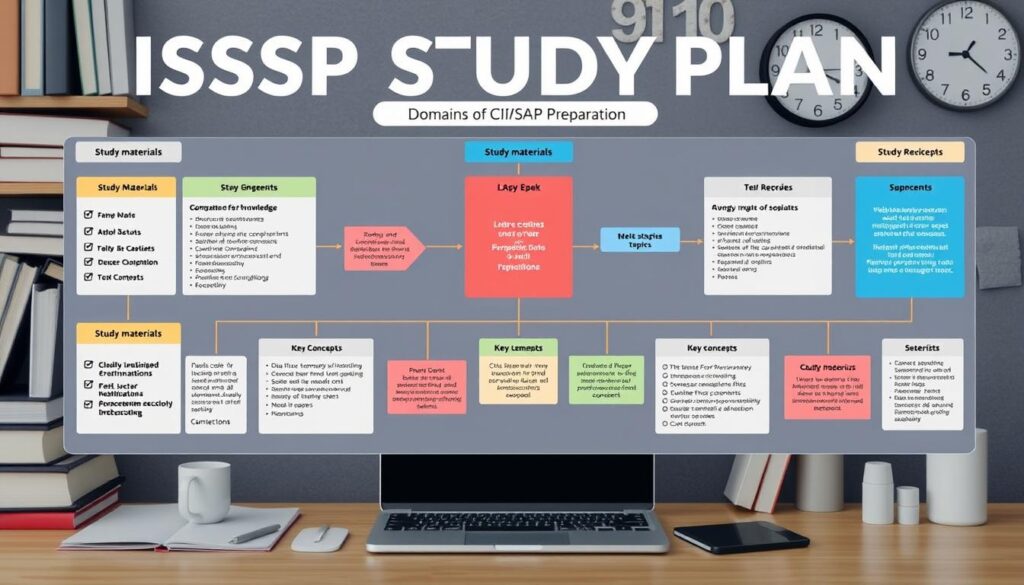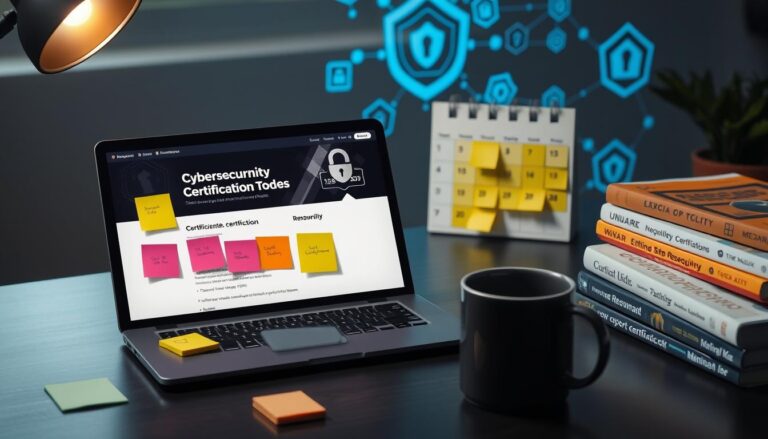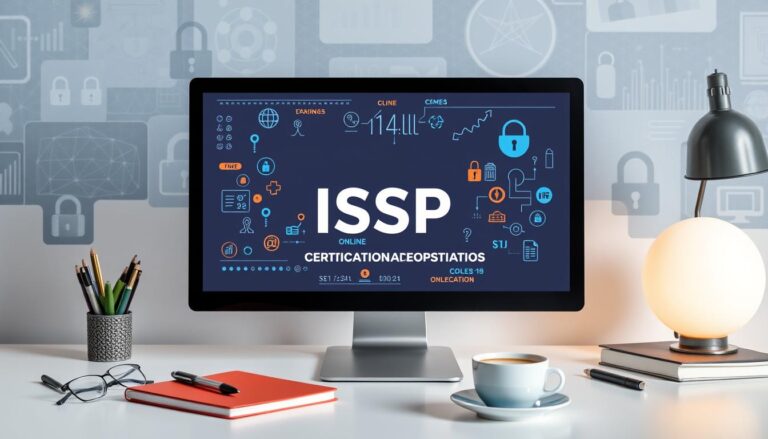
Did you know there are over 140,000 CISSP professionals worldwide as of 2023? Also, the U.S. expects around 800,000 cybersecurity job openings by 2024. This shows how vital the CISSP certification is in cybersecurity. Yet, the CISSP exam has a pass rate of only 20% to 25%. This makes good preparation key for those aiming to prove their skills and land a good job.
In this guide, we’ll share vital knowledge and strategies to pass the CISSP certification. Knowing the exam’s content, structure, and top study resources can greatly improve your success chances. With practical tips and effective study methods, you’ll be ready to tackle the challenges of this prestigious certification.
Understanding the CISSP Certification
The CISSP certification is given by (ISC)². It’s a key credential for those in cybersecurity. It shows a person’s skill in managing and designing security systems. It also proves they know a lot about important information security topics.
The CISSP exam tests knowledge in eight main areas. These areas make up the (ISC)² Common Body of Knowledge (CBK). They help professionals deal with today’s security issues. To get certified, you need at least five years of work experience in two of these areas. But, if you don’t have enough experience, you can start with the ISC2 Associate program.
The CISSP certification is very valuable in the job market. It can really boost your career, with salaries over $120,000 in North America. To keep your certification, you must get 120 Continuing Professional Education (CPE) credits every three years.
In April 2024, the CISSP exam will change to a Computerized Adaptive Testing (CAT) format. This will make the exam more personal. You’ll face 100 to 150 questions that change based on your answers. You’ll have three hours to finish. This update aims to make the exam more efficient and relevant to today’s cybersecurity needs.
CISSP Exam Requirements and Prerequisites
To get the (ISC)² certification, you must meet certain requirements. You need at least five years of work experience in two or more of the eight CISSP domains. These domains include important areas like Security and Risk Management and Asset Security.
Educational background can also help. If you have a four-year college degree or a recognized credential, you might get a one-year experience waiver. This means you only need four years of work experience instead of five.
Work experience can come from different jobs. Both full-time and part-time jobs can count towards the required experience. For example, 1,040 hours of part-time work equals six months of full-time experience.
Internships, paid or unpaid, can also count if documented well. The experience must match full-time Information Security work in the domains set by (ISC)².
After passing the CISSP exam, you need an endorsement from an active (ISC)² member to get certified. You also have to complete 40 Continuing Professional Education (CPE) credits every year. Knowing these requirements helps you prepare for a career in information security and management.
CISSP Exam Format and Structure
The CISSP exam format has changed to make it better for candidates. Starting April 15, 2024, it will use Computerized Adaptive Testing (CAT) for English tests. This new method can cut exam time from 5-6 hours to just 3 hours.
The exam has 100 to 150 multiple-choice questions from eight CISSP domains. These domains cover important areas like Security Governance and Risk Management. You need to answer at least 75 scored questions to pass. You also get to try 25 unscored questions.
Each CISSP domain has a different weight in the test. This helps you understand information security better. Here’s how the weights are divided:
| CISSP Domain | Weight (%) |
|---|---|
| Security and Risk Management | 16% |
| Asset Security | 10% |
| Security Architecture and Engineering | 13% |
| Communication and Network Security | 13% |
| Identity and Access Management (IAM) | 13% |
| Security Assessment and Testing | 12% |
| Security Operations | 13% |
| Software Development Security | 10% |
Knowing the CISSP exam format and structure helps you study better. It lets you focus your time and feel more confident during the exam. Good preparation means mastering the domains, understanding the questions, and adjusting your study plan.
Developing a Comprehensive Study Plan
A good CISSP study plan is key to passing the exam. First, look at your schedule to fit study time into your life. Find hours that work for you, balancing work and personal life. This helps you learn well and stay focused.
Creating a Schedule That Works for You
Everyone learns differently. Making a study plan that fits you is important. Here’s how to make your CISSP study plan:
- Choose daily and weekly study times that fit your life.
- Focus on hard topics first.
- Take breaks to remember what you’ve learned and avoid getting tired.
- Join study groups for help and extra resources.
Allocating Time to Each Domain
The CISSP exam has eight domains, each needing your full attention. Spend study time based on what you’re good at and what you need to work on:
| Domain | Recommended Study Time (Hours) | Current Understanding Level | Action Plan |
|---|---|---|---|
| Security and Risk Management | 20 | Intermediate | Review and practice questions |
| Asset Security | 15 | Beginner | Focused reading and flashcards |
| Security Engineering | 18 | Advanced | Practice tests and review |
| Communication and Network Security | 20 | Intermediate | Join study group discussions |
This table shows how to plan study time for each CISSP domain. Use practice tests to check your progress and adjust your plan as needed. This ensures you’re fully ready for the exam.

CISSP Exam Preparation Resources
Getting ready for the CISSP exam needs the right tools. You can use study guides, online courses, and practice exams to help. This section shows you the top resources for studying.
Recommended Books and Study Guides
Good CISSP study materials are key to understanding the exam. “CISSP Official Study Guide” and “Eleventh Hour CISSP” are top picks. They break down hard topics into easy parts.
Online Courses for Dedicated Learning
Online CISSP courses offer structured learning. They have interactive lessons and quizzes. ISC2’s courses are detailed and prepare you well for the exam.
Practice Questions and Exam Simulators
Using practice exam resources boosts your exam readiness. You get over 1,100 practice questions. Half are domain-based, and the other half mimic the real exam’s timing and weight.
Many candidates do well with practice questions. They often do up to 30 exams before passing. The questions are tough, making them feel ready for the real test.
| Resource Type | Details | Cost | Practice Questions |
|---|---|---|---|
| Books | CISSP Official Study Guide, Eleventh Hour CISSP | Varies | N/A |
| Online Courses | Structured learning with interactive content | Access for $24.99 (6 months) | N/A |
| Practice Exams | Over 1,100 questions updated weekly | Included with online access | 1,100+ |
CISSP Exam Preparation Strategies
Getting ready for the CISSP exam needs a solid plan. You should use many ways to learn. This way, you’ll understand and remember key concepts better. The exam is tough, so you need different resources to really get it.
Utilizing Multiple Study Sources
Using multiple study sources helps a lot. You can find:
- Textbooks that explain things clearly and give you a strong base.
- Video lectures that show how concepts work in real life.
- Online forums where you can talk to others and learn from them.
- Study groups for working together and discussing hard topics.
Mixing these resources into your study plan helps you cover all the CISSP domains. Many people say working with others makes hard subjects clearer and easier to understand.
Taking Practice Exams Effectively
It’s key to include effective practice exams in your study plan. Taking practice exams often helps you get used to the exam’s style and time limits. Here are some tips to make the most of practice exams:
- Take practice exams regularly to check your knowledge and find areas you need to work on.
- Look over your answers after each exam to see where you went wrong and how to do better.
- Work on managing your time during practice exams to get good at finishing on time.
- Think about joining a bootcamp or intensive course. Many people say they remember more when they take the exam right after.
By using practice exams well and combining them with other study tools, you can improve your CISSP exam prep. This will make you feel more confident and ready for the test.
Tips for Passing the CISSP Exam
Passing the CISSP exam requires a solid grasp of key concepts and smart time management. It’s vital to learn essential terms and definitions well. This knowledge is the base for answering questions correctly. Make sure you’re familiar with the technical terms used in cybersecurity.
Understanding Key Concepts and Terms
Key concepts are essential for the CISSP exam. Focus on these areas to improve your prep:
- Risk Management
- Access Control Models (e.g., DAC, MAC, and RBAC)
- Security Architecture and Design
- Operational Security
- Security Assessment and Testing
Joining community resources like forums and study groups can help deepen your understanding. Use platforms like Discord Certificate Station for ongoing learning and discussions.
Developing Time Management Skills
Effective time management is key to doing well in the CISSP exam. Here are some tips to help:
- Plan your exam pacing. Try to finish a big chunk of questions, like 120, in the first two hours.
- Take breaks to refresh your mind. This can help you stay focused on the remaining questions.
- Practice time management with mock exams. This simulates the test environment and helps you get used to the question format and time limits.
By balancing knowledge retention with efficient time use, you’ll boost your chances of passing the CISSP exam. Regular practice and a deep understanding of key concepts will set you up for success.
CISSP Exam Preparation Best Practices
Getting ready for the CISSP exam is tough. But, using the right strategies can really help. Joining study groups and using active learning can make a big difference.
Joining Study Groups and Forums
Study groups offer a chance to meet others with the same goals. They help you talk about the CISSP exam’s eight domains. You’ll get new ideas and clear up tough spots.
Make sure to set aside time each week for your group. You can meet in person or online. Use this time to go over the material and practice questions.
Engaging in Active Learning Methods
Active learning is key to really getting the CISSP material. Try teaching what you’ve learned or joining in on discussions. These methods help you remember and feel more confident.
Also, doing practice exams can help you get used to the real test. It shows you where you need to work harder. Mix these methods to get a full grasp of the material.

| Best Practice | Description |
|---|---|
| Study Groups | Engage in discussions and share insights with peers for deeper understanding. |
| Active Learning | Utilize methods like teaching concepts or participating in discussions. |
| Practice Exams | Simulate the exam environment to identify weak areas and boost confidence. |
| Regular Review | Schedule consistent review sessions throughout your preparation timeline. |
Last-Minute Review Techniques
As the CISSP exam gets closer, using effective last-minute review techniques is key. It helps solidify your knowledge and boosts your confidence. Focus on important concepts and how to take the test to do well.
Final Practice Exams
Final practice exams are a great way to check if you’re ready. Doing a full-length exam helps you get used to the real test’s timing and style. Try to use exams that use the Computerized Adaptive Testing (CAT) format.
This format changes based on your skill level, making practice more effective. Studies show that those who practice with these exams tend to score around 80%.
Reviewing Flashcard Concepts
Flashcard review is a smart way to quickly go over key terms and definitions before the exam. Make sure your flashcards cover all eight CISSP domains. Use spaced repetition to help you remember better.
This method means you review tricky terms often. It helps clear up any doubts and makes sure you understand everything. This will help you do well on the test.
CISSP Exam Preparation for Success
Getting ready for the CISSP exam is more than just knowing the material. It’s about balancing your mental and physical health. Having a positive mindset is key to your success. It helps you face the challenges of exam prep with confidence.
Trust in your knowledge. All the studying and experience you’ve gained will be your strength on exam day.
Maintaining a Positive Mindset
Staying positive can greatly improve your performance. Try affirmations and visualization to boost your confidence. Reminding yourself of your prep work helps create a success mindset.
Don’t forget to relax and take care of yourself. This balance is important as the exam gets closer.
Trusting Your Knowledge Before the Exam
Your confidence comes from all the hard work on the CISSP domains. Use practice exams and self-assessments to solidify your knowledge. Knowing the exam content well can reduce anxiety and prepare you for the test.
Make sure to get enough rest before the exam. This will help you remember important details and answer questions clearly. A positive mindset and trust in your prep are essential for the CISSP exam.
Conclusion
Getting your CISSP certification is a big step towards a great cybersecurity career. Use a clear plan for studying and try different study tools. This will help you build a strong base for passing the exam.
Setting goals is key to doing well. It helps you stay focused and work smarter. This way, you can reach your goals faster.
Being accountable and talking with others is very important. Joining study groups and sharing what you learn helps a lot. Teaching others boosts your own learning and memory.
Remember, the CISSP exam has 125 to 175 questions. You have four hours to finish it. Being well-prepared is essential.
Passing the CISSP exam opens up new doors in cybersecurity. Study hard and stay confident. Every hour you study brings you closer to your dream.
Your hard work and dedication will lead to a fulfilling career. Start your CISSP journey now. Face the challenges head-on.
Source Links
- CISSP Mastery: The Ultimate Study Guide for the 2024-2025 CISSP Exam
- Best CISSP Study Guides for 2025 + CISSP Study Plan
- YOUR ULTIMATE CISSP EXAM GUIDE | Bilginç IT Academy
- How to Pass The CISSP Exam in Your First Attempt
- What Is CISSP Certification? Should You Get It & How To Prep
- CISSP Training and Certification
- CISSP Exam Requirements
- CISSP Exam Requirements & Prerequisites: Eligibility and Work Experience
- CISSP Experience Requirements
- CISSP Exam Outline
- Discover the Latest CISSP Exam Format & Adaptive Testing Insights
- CISSP Exam Preparation Tips: How to Study Effectively
- CISSP Exam Prep: Developing A Study Plan For Success – BridgingMinds Network
- CISSP Exam Prep – The Best and Most Accurate CISSP Practice Exams
- Preparing for the ISC2 CISSP Exam
- How to prepare for the CISSP exam: Tips from industry leaders – Help Net Security
- CISSP Exam Prep – The Best and Most Accurate CISSP | Edureka
- 5 Easy Steps to Prepare for Your CISSP Exam
- How I Passed CISSP — Strategy, Tactics, Materials and Creativity
- How I passed CISSP, and you can too!
- How to Prepare for the CISSP Exam: Tips and Tricks from Certified Professionals | FRSecure
- How To Prepare For CISSP Exam in 2024
- CISSP Exam Prep: Proven Strategies to Study and Pass with Confidence
- How I Passed the CISSP Exam in 6 Weeks
- 8 tips for CISSP exam success in 2025
- Top Study Tips for Passing the CISSP Exam on Your First Try
- Can You Pass the CISSP Exam in 3 Months? Proven Tips Inside!
- How to Pass the CISSP Exam in First Attempt (2025)
- Preparing for CISSP Exam
- How i passed CISSP – A Minimalistic Approach to Success



